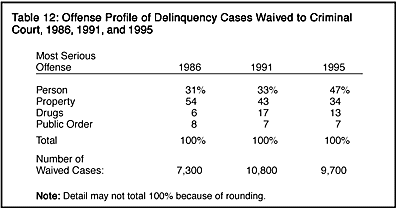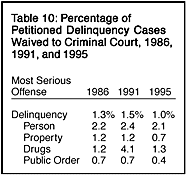|
Judicial Decision and Disposition Waiver
Between 1986 and 1994, the number of delinquency cases judicially waived to criminal court increased 60% and then from 1994 to 1995 dropped 17%. The net result was that the number of cases judicially waived was 33% greater in 1995 than in 1986 (table 11). The greatest relative change between 1986 and 1995 in waived cases (100% or more) was found among person offense and drug cases. The increase in waived public order cases was small by comparison (8%) and among property cases there was a decline (18%).  The pattern of change in the number of waived cases between 1986 and 1995 varied across offense categories (figure 3). For property and drug cases, the number of waived cases increased from 1986 through 1991 and declined substantially after 1991. Waived propertycases increased 15% and then dropped 29%; waived drug cases rose 314% and then dropped 32%. For person offense and public order cases, the number of waived cases increased steadily through 1994 and then dropped off in 1995. Waived person offense cases increased 125% from 1986 through 1994 and then dropped 11% in 1995; waived public order cases rose 60% and then dropped 33%.  As a result, the offense profile of cases judicially waived to criminal court changed considerably between 1986 and 1995. The proportion of all waived delinquency cases that involved a property offense as the most serious charge declined from 54% in 1986 to 34% in 1995 (table 12). In 1995, the largest group of waived cases involved person offenses, which accounted for nearly half of all cases waived to criminal court. The proportion of person offenses among judicially waived cases grew from 31% to 47%. Drug offense cases increased from 6% of all waivers in 1986 to a high of 17% in 1991 and then declined to 13% in 1995. The proportion of public order cases among waived cases has held steady between 7% and 9%. 
|
 Judicial waivers to criminal court represented 1% of all petitioned delinquency cases in 1995 (table 10). The cases most likely to be judicially waived in 1995 were those involving person offenses (2.1%). This was true in 1986 as well. In 1991, however, drug offense cases were more likely to be waived than person offense cases (4.1% versus 2.4%). Fewer than 1% of cases involving property offenses were waived to criminal court in 1995, which was down from 1.2% in 1986.
Judicial waivers to criminal court represented 1% of all petitioned delinquency cases in 1995 (table 10). The cases most likely to be judicially waived in 1995 were those involving person offenses (2.1%). This was true in 1986 as well. In 1991, however, drug offense cases were more likely to be waived than person offense cases (4.1% versus 2.4%). Fewer than 1% of cases involving property offenses were waived to criminal court in 1995, which was down from 1.2% in 1986.